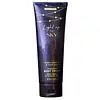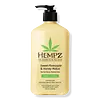What's inside
What's inside
 Key Ingredients
Key Ingredients

No key ingredients
 Benefits
Benefits

 Concerns
Concerns

 Ingredients Side-by-side
Ingredients Side-by-side

Water
Skin ConditioningCetyl Alcohol
EmollientStearyl Alcohol
EmollientParfum
MaskingCaprylic/Capric Triglyceride
MaskingCeteareth-20
CleansingDimethicone
EmollientGlyceryl Dilaurate
EmollientAloe Barbadensis Leaf Juice
Skin ConditioningDehydroacetic Acid
PreservativeAminomethyl Propanol
BufferingButyrospermum Parkii Butter
Skin ConditioningCocos Nucifera Oil
MaskingTheobroma Cacao Seed Butter
EmollientBenzyl Alcohol
PerfumingAcrylates/C10-30 Alkyl Acrylate Crosspolymer
Emulsion StabilisingWater, Cetyl Alcohol, Stearyl Alcohol, Parfum, Caprylic/Capric Triglyceride, Ceteareth-20, Dimethicone, Glyceryl Dilaurate, Aloe Barbadensis Leaf Juice, Dehydroacetic Acid, Aminomethyl Propanol, Butyrospermum Parkii Butter, Cocos Nucifera Oil, Theobroma Cacao Seed Butter, Benzyl Alcohol, Acrylates/C10-30 Alkyl Acrylate Crosspolymer
Water
Skin ConditioningIsopropyl Palmitate
EmollientButylene Glycol
HumectantPropanediol
SolventGlycerin
HumectantButyrospermum Parkii Butter
Skin ConditioningDimethicone
EmollientSorbitan Stearate
EmulsifyingParfum
MaskingStearic Acid
CleansingGlyceryl Stearate
EmollientPEG-100 Stearate
Cannabis Sativa Seed Oil
EmollientAnanas Sativus Fruit Extract
Skin ConditioningCucumis Melo Fruit Extract
Skin ConditioningCocos Nucifera Oil
MaskingPersea Gratissima Oil
Skin ConditioningSimmondsia Chinensis Seed Oil
EmollientAloe Barbadensis Leaf Juice
Skin ConditioningChamomilla Recutita Flower Extract
MaskingCucumis Sativus Fruit Extract
EmollientCalendula Officinalis Flower Extract
MaskingZingiber Officinale Root Extract
MaskingHelianthus Annuus Seed Oil
EmollientAlthaea Officinalis Root Extract
Skin ConditioningPanax Ginseng Root Extract
EmollientSymphytum Officinale Leaf Extract
Skin ConditioningPhenoxyethanol
PreservativeCetyl Alcohol
EmollientPolysorbate 40
EmulsifyingLimonene
PerfumingChlorphenesin
AntimicrobialCarbomer
Emulsion StabilisingNylon-12
Aminomethyl Propanol
BufferingEthylhexylglycerin
Skin ConditioningTocopheryl Acetate
AntioxidantDisodium EDTA
Benzyl Benzoate
AntimicrobialLinalool
PerfumingTocopherol
AntioxidantCI 19140
Cosmetic ColorantCI 15985
Cosmetic ColorantAscorbic Acid
AntioxidantRetinyl Palmitate
Skin ConditioningCI 16035
Cosmetic ColorantCitric Acid
BufferingPotassium Sorbate
PreservativeSodium Benzoate
MaskingWater, Isopropyl Palmitate, Butylene Glycol, Propanediol, Glycerin, Butyrospermum Parkii Butter, Dimethicone, Sorbitan Stearate, Parfum, Stearic Acid, Glyceryl Stearate, PEG-100 Stearate, Cannabis Sativa Seed Oil, Ananas Sativus Fruit Extract, Cucumis Melo Fruit Extract, Cocos Nucifera Oil, Persea Gratissima Oil, Simmondsia Chinensis Seed Oil, Aloe Barbadensis Leaf Juice, Chamomilla Recutita Flower Extract, Cucumis Sativus Fruit Extract, Calendula Officinalis Flower Extract, Zingiber Officinale Root Extract, Helianthus Annuus Seed Oil, Althaea Officinalis Root Extract, Panax Ginseng Root Extract, Symphytum Officinale Leaf Extract, Phenoxyethanol, Cetyl Alcohol, Polysorbate 40, Limonene, Chlorphenesin, Carbomer, Nylon-12, Aminomethyl Propanol, Ethylhexylglycerin, Tocopheryl Acetate, Disodium EDTA, Benzyl Benzoate, Linalool, Tocopherol, CI 19140, CI 15985, Ascorbic Acid, Retinyl Palmitate, CI 16035, Citric Acid, Potassium Sorbate, Sodium Benzoate
Ingredients Explained
These ingredients are found in both products.
Ingredients higher up in an ingredient list are typically present in a larger amount.
Aloe Barbadensis Leaf Juice comes from leaves of the aloe plant. Aloe Barbadensis Leaf Juice is best known for helping to soothe sunburns. It is also anti-inflammatory, moisturizing, antiseptic, and can help heal wounds.
Aloe is packed with good stuff including Vitamins A, C, and E. These vitamins are antioxidants, which help fight free-radicals and the damage they may cause. Free-radicals are molecules that may damage your skin cells, such as pollution.
Aloe Barbadensis Leaf Juice also contains sugars. These sugars come in the form of monosaccharides and polysaccharides, folic acid, and choline. These sugars are able to help bind moisture to skin.
It also contains minerals such as calcium, 12 anthraquinones, fatty acids, amino acids, and Vitamin B12.
Learn more about Aloe Barbadensis Leaf JuiceAminomethyl Propanol is used to adjust the pH of products. It is also used as a base to create other organic compounds. Having a balanced pH is important for protecting your skin.
Aminomethyl propanol is safe to use in cosmetics up to 1%. It is soluble in water.
This ingredient is also known as shea butter. It is an effective skin hydrator and emollient.
Emollients help soothe and soften your skin. It does this by creating a protective film on your skin. This barrier helps trap moisture and keeps your skin hydrated. Emollients may be effective at treating dry or itchy skin.
Shea butter is rich in antioxidants. Antioxidants help fight free-radicals, or molecules that may harm the body. It is also full of fatty acids including stearic acid and linoleic acid. These acids help replenish the skin and keep skin moisturized.
While Shea Butter has an SPF rating of about 3-4, it is not a sunscreen replacement.
Shea butter may not be fungal acne safe. We recommend speaking with a professional if you have any concerns.
Learn more about Butyrospermum Parkii ButterCetyl Alcohol is a fatty alcohol. Fatty Alcohols are most often used as an emollient or to thicken a product.
Its main roles are:
Though it has "alcohol" in the name, it is not related to denatured alcohol or ethyl alcohol.
The FDA allows products labeled "alcohol-free" to have fatty alcohols.
Learn more about Cetyl AlcoholCocos Nucifera Oil is obtained from the kernels of the coconut fruit. In other words, this is coconut oil.
Coconut Oil is rich in fatty acids with lauric acid making up the majority of these. It also contains linoleic acid. Due to this high fatty acid content, coconut oil helps trap moisture and soften skin.
Despite being antibacterial, coconut oil may not be great for acne-prone skin. It is comedogenic and may clog pores. This ingredient may not be safe for malassezia or fungal acne.
Note: Coconut Oil should not replace your sunscreen for UV protection. Studies show it only blocks about 20% of UV.
This oil is non-volatile and has a light scent.
The term 'fragrance' is not regulated in many countries. In many cases, it is up to the brand to define this term. For instance, many brands choose to label themselves as "fragrance-free" because they are not using synthetic fragrances. However, their products may still contain ingredients such as essential oils that are considered a fragrance.
Learn more about Cocos Nucifera OilDimethicone is a type of synthetic silicone created from natural materials such as quartz.
What it does:
Dimethicone comes in different viscosities:
Depending on the viscosity, dimethicone has different properties.
Ingredients lists don't always show which type is used, so we recommend reaching out to the brand if you have questions about the viscosity.
This ingredient is unlikely to cause irritation because it does not get absorbed into skin. However, people with silicone allergies should be careful about using this ingredient.
Note: Dimethicone may contribute to pilling. This is because it is not oil or water soluble, so pilling may occur when layered with products. When mixed with heavy oils in a formula, the outcome is also quite greasy.
Learn more about DimethiconeParfum is a catch-all term for an ingredient or more that is used to give a scent to products.
Also called "fragrance", this ingredient can be a blend of hundreds of chemicals or plant oils. This means every product with "fragrance" or "parfum" in the ingredients list is a different mixture.
For instance, Habanolide is a proprietary trade name for a specific aroma chemical. When used as a fragrance ingredient in cosmetics, most aroma chemicals fall under the broad labeling category of “FRAGRANCE” or “PARFUM” according to EU and US regulations.
The term 'parfum' or 'fragrance' is not regulated in many countries. In many cases, it is up to the brand to define this term.
For instance, many brands choose to label themselves as "fragrance-free" because they are not using synthetic fragrances. However, their products may still contain ingredients such as essential oils that are considered a fragrance by INCI standards.
One example is Calendula flower extract. Calendula is an essential oil that still imparts a scent or 'fragrance'.
Depending on the blend, the ingredients in the mixture can cause allergies and sensitivities on the skin. Some ingredients that are known EU allergens include linalool and citronellol.
Parfum can also be used to mask or cover an unpleasant scent.
The bottom line is: not all fragrances/parfum/ingredients are created equally. If you are worried about fragrances, we recommend taking a closer look at an ingredient. And of course, we always recommend speaking with a professional.
Learn more about ParfumWater. It's the most common cosmetic ingredient of all. You'll usually see it at the top of ingredient lists, meaning that it makes up the largest part of the product.
So why is it so popular? Water most often acts as a solvent - this means that it helps dissolve other ingredients into the formulation.
You'll also recognize water as that liquid we all need to stay alive. If you see this, drink a glass of water. Stay hydrated!
Learn more about Water